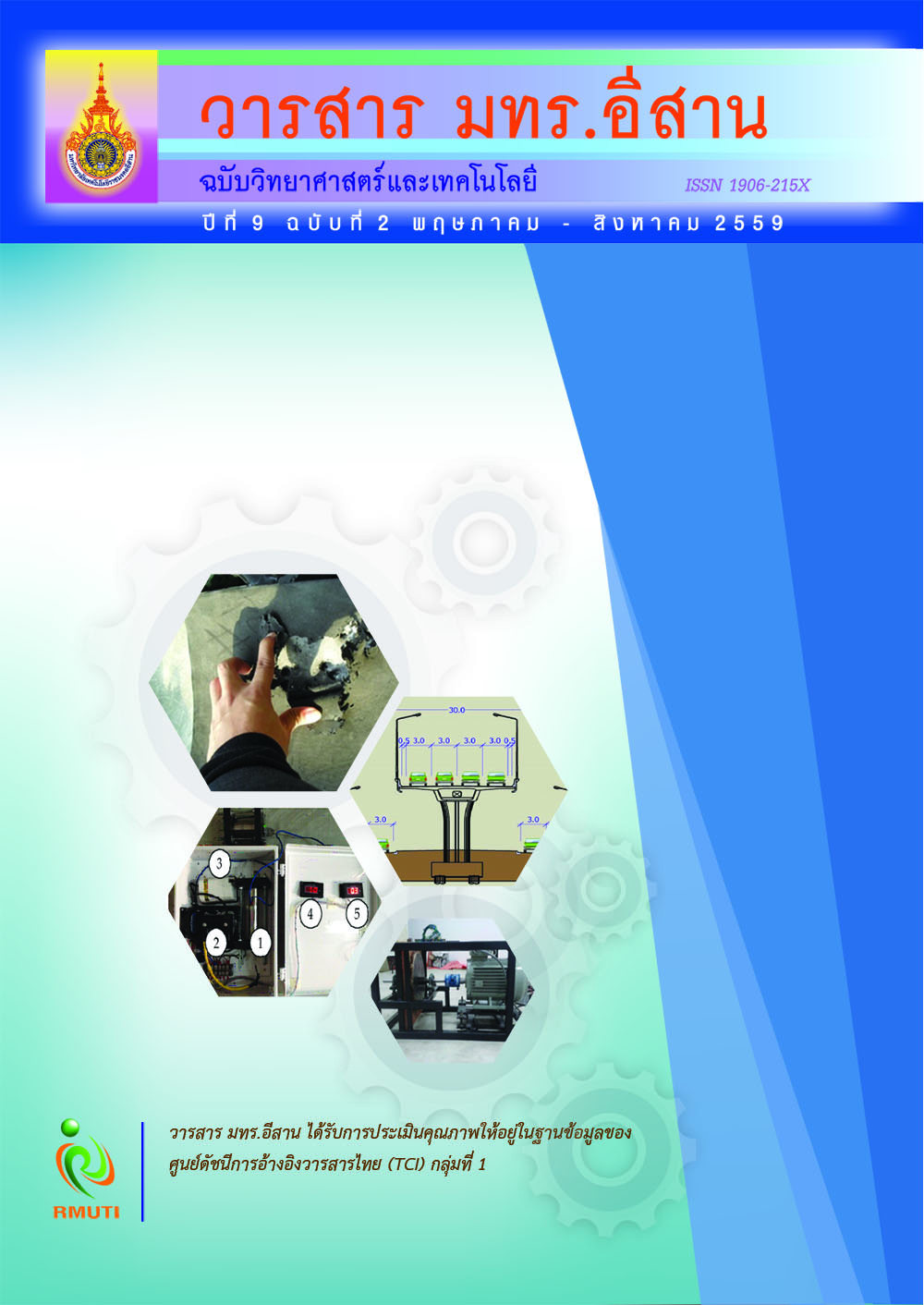การใช้ปลายข้าวหอมนิลและปลายข้าวกํ่าเป็นแหล่งพลังงานทดแทนปลายข้าวขาว ในสูตรอาหารสุกรหลังหย่านม The Use of Hom-Nil Broken Rice and Purple Broken Rice as Energy Source Replaced White Broken Rice in Post-Weaned Pig Diets
Main Article Content
Abstract
บทคัดย่อ
งานวิจัยครั้งนี้มีวัตถุประสงค์เพื่อศึกษาผลการใช้ปลายข้าวหอมนิล และปลายข้าวกํ่าทดแทนปลายข้าวขาว
ในสูตรอาหารสุกรหลังหย่านม วางแผนการทดลองแบบสุ่มสมบูรณ์ภายในบล็อก ใช้สุกรหลังหย่านมเพศผู้ตอน
และเพศเมีย เพศละ 10 ตัว แบ่งเป็น 5 กลุ่ม (เพศผู้ 2 ตัว เพศเมีย 2 ตัว) เลี้ยงสุกรแต่ละตัวในคอกขังเดี่ยว
สุ่มสุกรให้ได้รับอาหาร 5 สูตร ดังนี้ สูตรที่ 1 อาหารผสมปลายข้าวขาว 100 เปอร์เซ็นต์ (สูตรควบคุม) สูตรที่ 2
และ 3 ใช้ปลายข้าวหอมนิลทดแทนปลายข้าวขาว 50 และ 100 เปอร์เซ็นต์ สูตรที่ 4 และ 5 ใช้ปลายข้าวกํ่า
ทดแทนปลายข้าวขาว 50 และ 100 เปอร์เซ็นต์ เลี้ยงสุกรโดยให้กินอาหารแบบเต็มที่นาน 4 สัปดาห์
จากนั้นฆ่าสุกรเก็บตัวอย่างมูล ลำไส้เล็ก และลำไส้ใหญ่ นำไปตรวจนับจำนวนจุลินทรีย์ และการเปลี่ยนแปลง
ของวิลไลในลำไส้เล็ก ผลการทดลองปรากฏว่าสมรรถภาพการผลิตในด้านอัตราการเจริญเติบโต และปริมาณ
อาหารที่กินต่อวันของสุกรที่ได้รับอาหารสูตรที่ 1 4 และ 5 ไม่แตกต่างทางสถิติ (P > 0.05) ส่วนสูตรที่ 2
และ 3 มีค่าตํ่ากว่าสูตรที่ 1 แต่อัตราการแลกเนื้อ และต้นทุนค่าอาหารต่อนํ้าหนักตัวที่เพิ่มขึ้น 1 กิโลกรัม
ของสุกรที่ได้รับอาหารทั้ง 5 สูตร ไม่แตกต่างทางสถิติ (P > 0.05) ในทำนองเดียวกันจำนวนจุลินทรีย์รวม
แลกติกแอซิดแบคทีเรียในมูล ลำไส้ส่วนต้น ลำไส้เล็กส่วนปลาย และรวมทั้งในมูลและลำไส้ของสุกรก็ไม่แตกต่างทางสถิติ (P > 0.05) ส่วนจุลินทรีย์โคลิฟอร์มในลำไส้ใหญ่ส่วนต้น และรวมในลำไส้และมูลของสุกรที่กินอาหารที่ใช้ปลายข้าวกํ่า และปลายข้าวหอมนิลทดแทนปลายข้าวขาว มีจำนวนน้อยกว่าในสุกรที่กินอาหารผสมปลายข้าวขาวเพียงอย่างเดียว นอกจากนี้วิลไลในลำไส้เล็กของสุกรที่กินอาหารผสมปลายข้าวหอมนิล และปลายข้าวกํ่าทั้ง 4 สูตร สูงกว่าวิลไลของสุกรที่กินอาหารผสมปลายข้าวขาว 100 เปอร์เซ็นต์ (P < 0.05)
Abstract
The objective of this study was to examine the effect of using of Hom-Nil and purple
broken rices as energy source to replace white broken rice in post-weaning pig diets.
Randomized complete block design was used in this experiment. Twenty post-weaned
pigs (castrated male and female) were divided into 5 groups of 4 pigs each. Each pig
was randomly fed with experimental diet as follows: diet 1, 100% of white broken rice;
diets 2 and 3: 50% and 100% of Hom-Nil broken rice replaced white broken rice; diets 4
and 5: 50% and 100% of purple broken rice replaced white broken rice. All pigs were
placed in separate pens where feeds and water were provided ad libitum for 4 weeks.
After cessation of feeding trial, the pigs were dissected in order to determine microorganism
count in feces, ileum and colon and to investigate morphological change of villi in small
intestine. Results showed that, average daily gain and daily feed intake of pigs fed
diets 1, 4 and 5 were not statistically different. There were no significant statistical
difference among the 5 groups on feed conversion ratio and cost per 1 kilogram weight
gain (P > 0.05). However, the average daily gain and daily feed intake of pigs fed diets 2
and 3 were lower than diet 1. Additionally, there were no statistical differences among
the 5 groups on number of microorganism in feces, ileum, colon and total of intestine
and feces (total plate count and lactic acid bacteria). The number of coliform in feces
and ileum were not significantly different among treatments (P > 0.05), except that in colon
and total of intestine and feces, the number of coliform in colon of pigs by diets 2 - 5 were
lower than diet 1. In addition, the villi in small intestine of pigs fed diets 2 - 5 were higher
than diet 1 (P < 0.05).
Article Details
References
Garcia-Ruiz, A.I. (2007). Effects of Type and Level of Fibre on Digestive Physiology
and Performance in Reproducing and Growing Rabbits. World Rabbit Sci. Vol. 15.
pp. 9-17
AOAC. (2000). Association of Office Analytical Chemist. 17th (ed) Association of Official
Chemist, Inc. Washington, D.C
Chamsai, S., Chalermsan, N., Anawatchakul, S., Panacharernsawat, S. and Jaree, T. (2014).
Comparing the Nutritive Value of Hom-Nil broken rice, Purple Broken Rice
and White Broken Rice in Post-Weaning Piglets. In Proceedings of Panyapiwat 4th,
Future of Thailand and Economic Crops Strategy. Panyapiwat Institute of
Management. Nonthaburi, Thailand. pp. G101-G108
Downes, F.P. and Ito, K. (2001). Compendium of Methods for the Microbiological
Examination of 4th ed. America Public Health Association. Washington D.C.
Jerome, B., Pascal, L. and Andre, B. (2008). Nutritional and Environmental Consequences
of Dietary Fibre in Pig Nutrition: a Review. Biotechnology, Agronomy, Society
and Environment. Vol. 12. No. 1. pp. 69-80
Just, A. (1982). The Influence of Crude Fiber from Cereals on the Net Energy Value of Diets
for Growth in Pigs. Livestock Production Science. Vol. 9. pp. 569-580
Kong, J. M., Chia, L.S., Goh, N.K., Chia, T. F., Brouillard, R. (2003). Analysis of Biological
Activities of Anthocyanins. Phytochem. Vol. 64. pp. 923-933
Kyriazkis, B.Y.I. and Emmans, G.C. (1995). The Voluntary Feed Intake of Pigs Given Feeds
Based on Wheatbran, Dried Citrus Pulp and Grass Meal, in Relation to Measurements
of Feed Bulk. British Journal of Nutrition. Vol. 73. pp. 191-207
NRC. (1998). Nutrient Requirements of swine: 10th Revised Edition. The National
Academies Press, Washington DC.
Phengrat, J. and Jearakongman, S. (2009). Black Glutinous Rice : Various Benefits, Composite
Thinking, Enhancing Thai Economic Opportunities. In Proceedings of temperate
Rice and Grain 2009. Chonburi, Thailand. pp. 325-342
Pongpiachan, P. (2004). Principle of Feed: Principle of Nutrition and Application No. 2.
O.S. Printing House, Bangkok, Thailand. p. 620
Pongpiachan, P., Pongpiachan, P., Punyatong, M. and Karladee, D. (2008). Effect of
Gammma Oryzanol and Proanthocyanidin of Purple Rice (Oryza sativa L.)
on Immune Response, Cancer cells and Blood Coagulation. Full paper report.
National Research Council of Thailand. Bangkok, Thailand
SAS. (1990). SAS/STAT User’s Guide (Vol. 2). SAS Inst. Inc., Cary, NC.
Somto, S. (2004). Physical and Chemical Characteristics and Stability of Thai Pigmented
Rice. Master of Science Thesis. Silpakorn University, Nakhon Pathom, Thailand
Thongta, K. (2007). Effects of Purple Glutinous Rice Bran (Oryza sativa L.) on Development
of Small intestine villi, Blood liquid Profile and Productive Performance in Weaned
Piglets. Master of Science Thesis. Chiangmai University, Chiangmai, Thailand
Ziggers, D. (2012). Dietary Fiber, the Missing Nutrient in Pig Production. Access (1 May 2014).
Available (http://www.allaboutfeed.net/Nutrition/Diet-Formulation/2011/11/
Dietary-fibre-the-missing-nutrient-in-pig-production-AAF012606W/)


